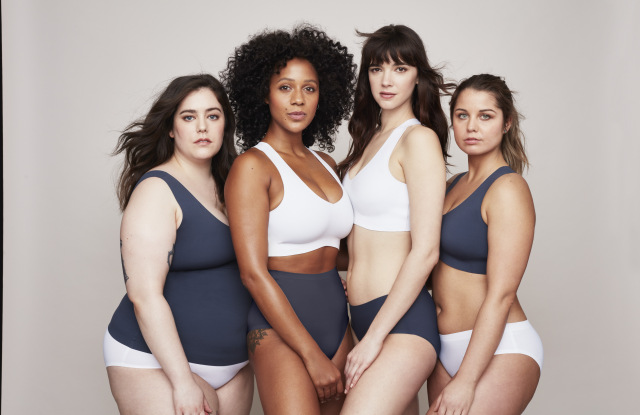Lingerie Is Getting a Lift From Newcomers Harnessing Digital, Fit Technologies
A sea change in how women view bras — along with fit technologies and social media — is helping a clutch of direct-to-consumer entrants make headway in the lingerie category as some of its brick-and-mortar stalwarts grapple with slowing sales.
This includes American lingerie brand Lively, founded by a former Victoria’s Secret executive, who spied an opportunity in more inclusive brand messaging and fit innovations.

“Victoria’s Secret owns a third to 40 percent, depending on what data you look at, of the U.S. lingerie market, which is around $13 billion,” said Michelle Cordeiro Grant, founder and chief executive officer of Lively. According to Zion Market Research, the global lingerie market was valued at $38.9 billion in 2017 and is expected to reach $59.5 billion by 2024.
Cordeiro Grant is a former Victoria’s Secret executive and it was during her time at the brand that she noticed a potential for differentiation in the sector. Sales were down 5 percent across Victoria Secret stores in the U.S. and Canada for 2018, according to L Brands’ June 2018 sales report.
“Their point of view on lingerie is how do women feel when their significant other is looking at them. What I felt from a branding standpoint was how do women feel when they look at themselves because what is ‘sexy’ today is being smart, healthy, active and confident,” said Cordeiro Grant.
Likewise, it was an experience at Victoria’s Secret that pushed Heidi Zak to launch American lingerie brand ThirdLove. “I was shopping for a bra, wondering why I was shopping with a brand that didn’t have a great product and also didn’t have a compelling message that resonated with me,” she said. “Generally, women dread bra shopping on average, and that was really the impetus to start ThirdLove.”
These new players developed new marketing strategies and braved new frontiers, entering into market via an unorthodox approach. They used e-commerce as a gateway into the industry, a difficult feat given the nature of the product.
To solve the fit dilemma, these brands have tapped hundreds of women to develop their individual online fit guide. Trusst Lingerie tested 300 prototypes on hundreds of women, Knix’s initial sizing system was based off of 220 women and Lively held 300,000 online sessions prior to its launch.

ThirdLove’s Zak wanted to digitize the expertise and knowledge of an in-store sales associate. She claims that its Fit Finder tool is close to being perfect and, to date, the brand has collected data from over 10 million women who have used the Fit Finder. The data informs product development, such as the development of half sizes, which the brand is renowned for. Over a third of ThirdLove’s customers purchase half sizes.
“We offer over 70 sizes including our half cups which nobody else offers, and we’re really able to analytically determine how many women are requesting certain sizes that we don’t offer,” said Zak. “Just a few weeks ago, we added 24 new sizes that were the top 24 requested sizes we didn’t carry.”
Being size inclusive is fundamental. At a time when people of all shapes and sizes are demanding to be acknowledged and celebrated, brands can no longer expect women to fit traditional cookie-cutter molds. “We have proper sizes, rather than just S, M, L. We have actual dimensions that are based off of your body to get your perfect fit rather than expect all women to fit into those three sizes,” said Faith Leeves, co-founder of U.K. brand Lara Intimates.
Lara Intimates’ fit guide is similar to ThirdLove’s Fit Finder, and brings the real-life experience of being fitted onto a digital platform. “It’s exactly how we would fit you if you came into our studios, so they don’t have to worry about what size they are at Victoria’s Secret or Marks & Spencer,” Leeves said.
“A lot of people think that underwear won’t work online, but I think as long as you help women feel really confident that they know what their body is going to look like in it, you can do it,” added Cindy Liberman, co-founder of Lara Intimates. “It’s getting them to measure themselves and make that first purchase. It’s building up that trust because the lingerie-buying experience is habitual.”
While Lara Intimates has a studio near Hackney Wick, two-thirds of its sales still happen online with the majority of sales targeted to the small back, large cup market that it’s managed to tap into.
Angel wings and provocative imagery are being replaced by real women with real bodies — including curves, scars and sagging. They strike fun and confident poses on these brands’ Web sites and their social media channels.
“All our campaign shoots feature real customers of Knix. We really let them tell their stories first and then the product and stores second. We’re just taking marketing to women on behalf of women instead of through a specific lens of what women should be,” said Joanna Griffiths of Canadian lingerie brand Knix.
For Griffiths, women must be able to visualize their needs online. Each size is shown on a model, and the brand has recently incorporated video on its Web site. “People don’t just want to see what they look like standing still; we want to show what our bras look like when you’re moving or (what it looks like) underneath a T-shirt,” she said.
Harnessing community engagement is a key strategy. Knix’s real customers have become official ambassadors who constantly test out new prototypes and provide feedback. Similarly, Lively has over 30,000 online ambassadors and encourages its customers to vote on its images and text.
Both of these brands also translate the online engagement offline. Spin classes, meditation and roundtable discussions are all part of the Knix community, while Lively offers succulent gardening, terrarium classes, watercolor classes and entrepreneurship workshops. And in England, Lara Intimates holds studio gatherings to talk about bra experiences, which are then shared online. The firm is also journeying across the country with a mobile underwear store to offer personalized fittings.
These digitally savvy lingerie newcomers say it’s important to move faster than their traditional counterparts. American brand Trusst Lingerie, which caters to the D-plus cup market, has developed its patented Breast Advanced Support Technology, BAST for short.
“It’s a completely new support system. Traditional bras just use straps to pull up the weight and use underwires which put tension on the sternum. We’ve created bras that lift from underneath and counterbalance the weight to relieve pain points such as back pain, neck strain and shoulder dents,” said ceo and co-founder Sophia Berman.
From customer feedback, Berman has noticed that having more options and different solutions resonates strongly with women. “They’re sick of the same industry-standard bras they have seen over and over again.”
Griffiths agreed: “There hasn’t been a ton of product innovation up to this point, partly due to the fact that there are only a couple of large manufacturers who produce the same thing.” Knix bras are moisture-wicking and anti-odor. For the eco-friendly consumer, Lara Intimates’ breathable lingerie is manufactured from deadstock fabric.
New alternatives include wireless bra options — and these new entrants have noticed a visible customer shift in favor of non-wired products. “It’s no longer about choosing between ‘sexy’ and ultimate comfort, that’s how we came up with our concept of “Leisurée” (lingerie and leisure). I think it’s really inspired by the emergence of athleisure and for some reason lingerie never went that way,” Cordeiro Grant said.
“I’m actually so surprised how many underwear brands are still so focused on this ultra sexy stuff, when I see people on Instagram constantly talking about how they want a fresher approach to underwear,” said Liberman.
Women no longer have to choose between being sexy and comfortable, and lingerie is quickly catching up. “There’s a big shift away from push-ups and padded bras. There’s this whole movement with women that almost started out with the sneaker trend, the idea that a woman is expected to wear stilettos and a pencil skirt is just not happening anymore and so I think that the bra is going to be the final thing that is adapting to a change in female preferences,” said Griffiths.